
MOST PEOPLE WILL NEVER WALK INTO AN ANIMAL SHELTER AND MOST ANIMALS WILL NEVER WALK OUT.
The recent closure of the Highveld Ridge SPCA has left many angry after the NSPCA came here twice in three months and euthanized many animals. Look, although I am not a supporter of the NSPCA or SPCA movement and think the NSPCA inspectors acted in a disgraceful manner, I believe many do not understand the reality of what is going on in terms of animal numbers. The NSPCA and SPCA movement is a whole other problem that needs to be addressed, but I will leave that for another day. Today, I will focus on the reality we face in animal welfare.
Euthanasia, or the humane ending of an animal’s life, remains a contentious issue within the realm of animal welfare. The decision to put animals to sleep is a heartbreaking and difficult one, often resulting from the overwhelming challenge of overpopulation. While organizations, such as animal welfare groups, strive to find homes for animals through adoption and marketing efforts, the sheer number of homeless and abused animals far exceeds available resources. In this article, we delve into the reasons behind the need for euthanasia (for now), emphasizing the importance of sterilization, education, responsible ownership, and the necessity for legislation in mitigating this crisis.
OVERPOPULATION CRISIS – THE NUMBERS
We have a MASSIVE OVERPOPULATION CRISIS on our hands. This is especially for cats and dogs, but birds, rabbits, and other animals too. Not just a problem…A CRISIS‼!
Millions of animals are taken in by shelters worldwide and unfortunately, millions are euthanized annually. THERE ARE JUST NOT ENOUGH HOMES for all these animals. I am not even talking about good homes (which is a whole other debate), just homes. If you have not volunteered in animal welfare, nor read our posts then you might not even begin to grasp the extent, so here is a bit of perspective:
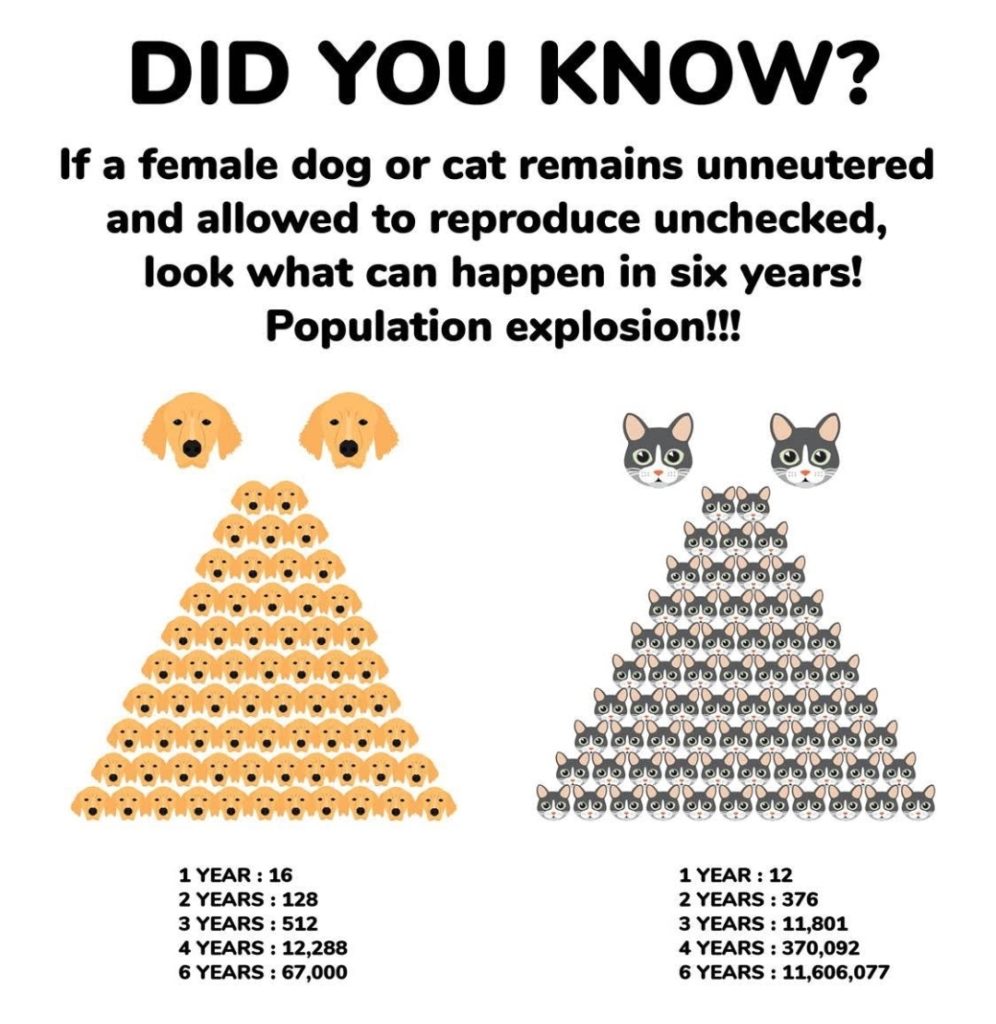
- It is estimated that 1 (one) unsterilized female dog, her female offspring, and their offspring over a period of 6 years can produce a total of 67 000 (sixty-seven thousand)) puppies. The equivalent situation is even worse for cats where it is estimated that 1 (one) unsterilized female cat, her female offspring and their offspring over 7 years can produce a total of 370 000 kittens.
- SPCA numbers: In one month, just three small to medium SPCAs received 982 animals; two-thirds were surrendered by owners, and a third were strays found in the streets. In South Africa, there are 69 SPCAs and an estimated 450 private shelters/NPOs. Out of the 982 animals mentioned earlier, only 50 were adopted, and 20 were claimed. This means that these three SPCAs only, had an excess of 912 animals. It comes to more than 90% of the animals having to be euthanized.
If you don’t want them to euthanize, what do you expect them to do with all the animals?
- A global pet homelessness index revealed that about 4 million animals (cats and dogs) are homeless in SA, with approximately 650,000 ending up in shelters.
- It is estimated that in SA, about 2800 animals are euthanized (put to sleep) per day due to a lack of available homes.
Animal welfare organizations received a staggering number of animals, creating an overflow that shelters struggle to accommodate. The breeding culture, supported by both “registered” and backyard breeders, exacerbates the problem, leading to the unavoidable reality of euthanasia. The overwhelming number of animals in need surpasses the capacity for available homes, placing an immense burden on organizations.
They breed them faster than we can safe them!
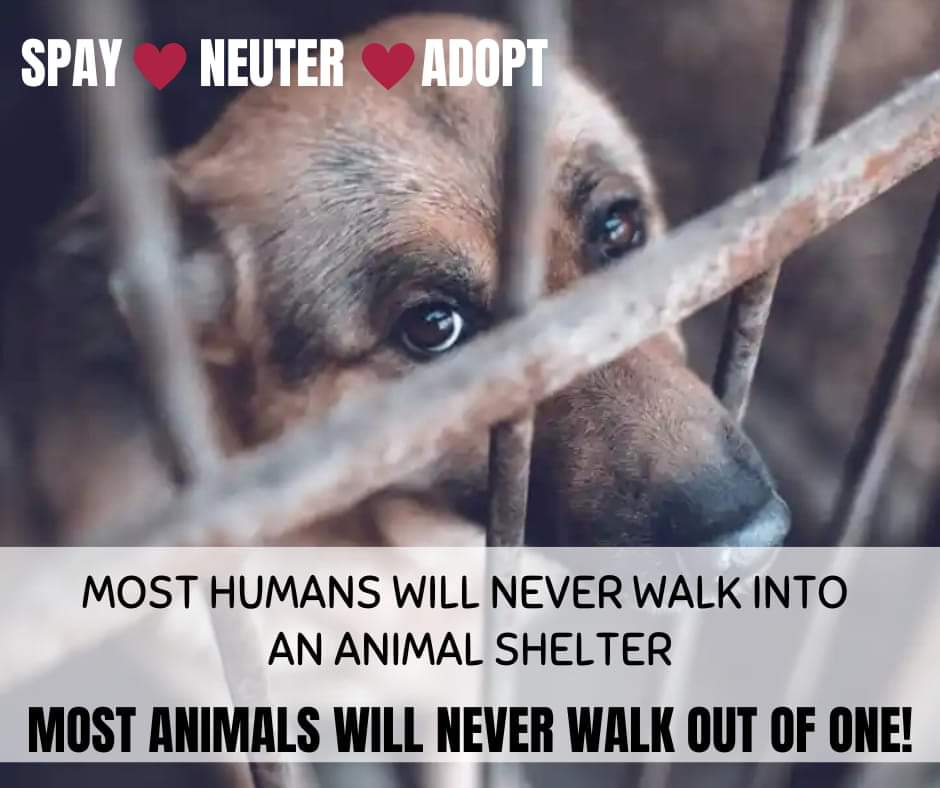
WHO IS TO BLAME?
To clarify, I don’t distinguish between backyard breeders, puppy mills, owners who allow their pets to have litters, and so-called “responsible” breeders. They are all causing the problem. No breeding is responsible when we have to humanely kill 2800 healthy animals a day.
Unregulated breeding, unregulated trading of animals as well as irresponsible ownership is the problem.
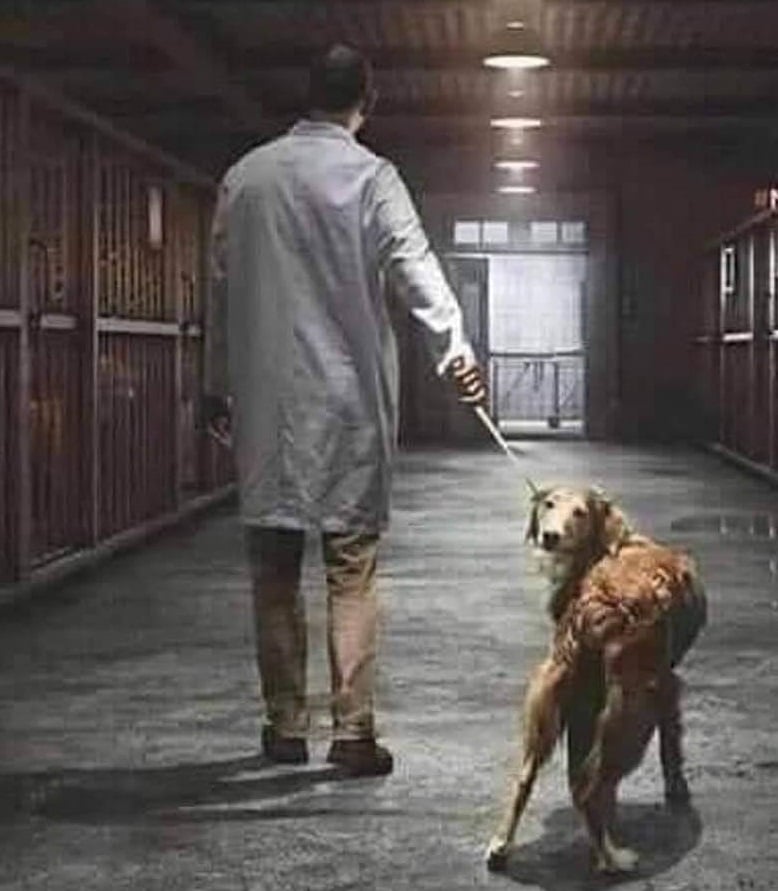
TODAY I TOOK MY FINAL WALK
Today I took my final walk…because you didn’t sterilise your pets and they had a litter!
Today I took my final walk…because you moved and I was not included in your plans!
Today I took my final walk…because you supported free to good home ads!
Today I took my final walk…because you supported breeders!
Today I took my final walk…because you kept breeding!
Today I took my final walk…because you let me roam the streets!
Today I took my final walk…because I didn’t suit your lifestyle!
Today I took my final walk….because you abandoned me!
Today I took my final walk…because you were too lazy to seek behavioural experts or to stimulate/exercise me!
Today I took my final walk…because there are just not enough homes for us all!
Today I took my final walk…because you are a selfish human!
Blame these people for the overpopulation crisis and be angry at them! You can also help by not doing or supporting any of the above!
We also need a shift in societal attitudes, urging people to adopt instead of supporting breeders and pet shops.
Read more here if you need to prepare to take your own pet for euthanasia.
THE ROLE OF ANIMAL WELFARE ORGANIZATIONS
Animal welfare organizations play a vital role in rescuing and caring for animals, often becoming the last resort for those in need. However, the limitations in available kennel space force organizations to make heart-wrenching decisions about which animals to keep and which ones, unfortunately, have to be euthanized. The emotional toll on staff is immense, as they bear witness to the consequences of irresponsible breeding and ownership and the same goes for the kind veterinarians who offer this service to organizations.
Even the shelters that are pro-life must either show animals away at some point or they must euthanize them for space. Both being terrible decisions. Keeping them in cages indefinitely is also cruel. I don’t know 10 people who want to adopt right now, do you?
Read more to understand this emotional experience and difficult decision for rescuer organisations or rescue veterinarians, when rescue animals take their final walk.
STERILIZATION AND FINANCIAL CONSTRAINTS
Another issue contributing to overpopulation is the lack of sterilization of companion animals. Financial constraints prevent many owners, especially in economically disadvantaged areas, from affording the cost of sterilization, which can range from R650 to R1200 or more. This economic dilemma forces individuals to choose between feeding their pets and sterilizing them. The burden falls on organizations like animal welfare groups to deal with the consequences.
In the Netherlands, they addressed this issue succesfully with stricter laws and making sterlization free and easily accessible.
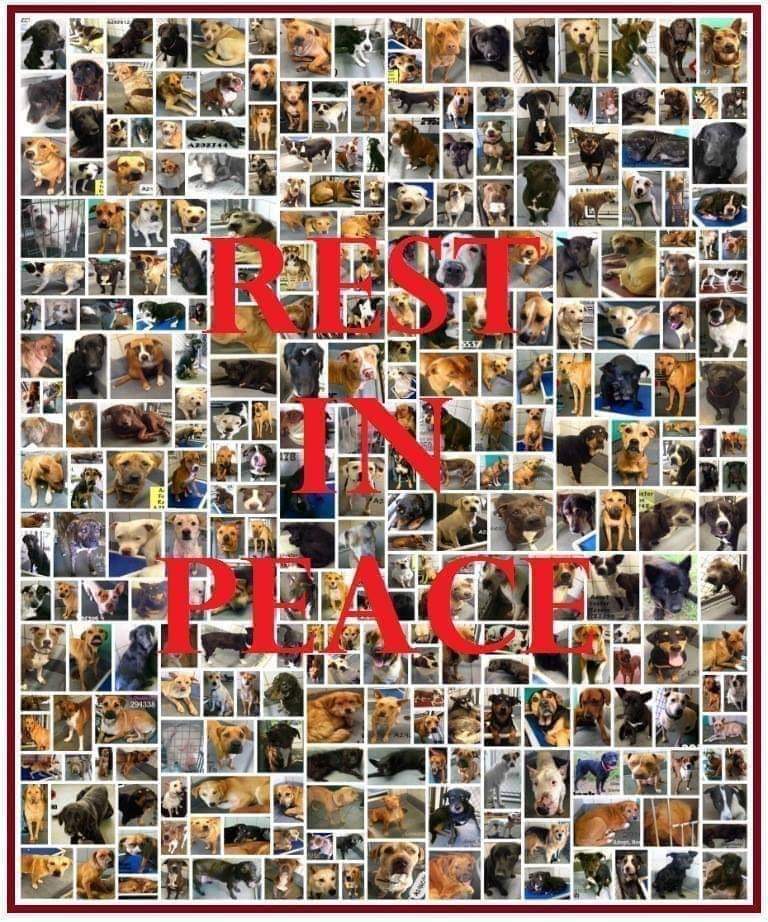
THE SOLUTION
THE NEED FOR LEGISLATION
Asking nicely has proven insufficient in addressing the root causes of overpopulation. Legislation will become a necessary tool to enforce compulsory sterilization and breeding regulations in South Africa. The government must also play a role in regulating the trade of animals and ensuring that responsible ownership practices are upheld. Without a legal frameworks, the cycle of irresponsible breeding will persist, leading to more animals in need and a continued reliance on euthanasia to manage the crisis.

THE IMPORTANCE OF STERILIZATION AND EDUCATION
Large-scale sterilization campaigns and educational initiatives emerge as crucial solutions to combat overpopulation. However, organizations face challenges in implementing these strategies due to financial constraints. While we don’t have enough legislation yet, the public will need to offer support to fund sterilization efforts.
Look, we should not stop sterilizing as every animal that cannot breed will not contribute to the problem, however, at this stage, it seems they are breeding animals faster than we can sterilize and safe them.
At a recent spay day shared by Change for the Better Foundation, they successfully handled 47 animals. However, 8 of them were pregnant. If allowed to give birth, these 35 babies would necessitate another spay day. We can’t get ahead if breeding is not regulated, creating a vicious cycle. Shelters can’t kill what they don’t receive!
Let that sink in.
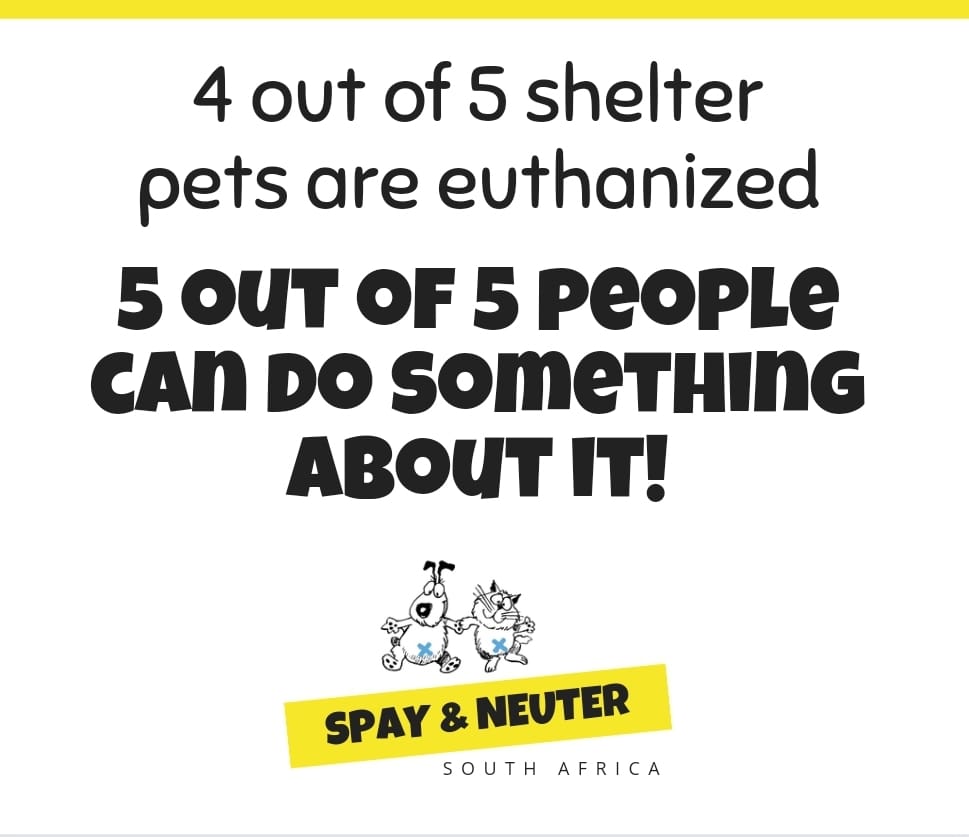
FACING THE REALITY
Animal welfare organizations are on the frontline, grappling with the heartbreaking decision of euthanasia due to limited resources and overwhelming demand. The plea is for individuals to understand the gravity of the situation and actively contribute to solutions. Whether through volunteering, adopting, financially supporting sterilization campaigns or supporting legislative effors……. everyone has a role to play in addressing the overpopulation crisis. This includes sterlization of your own animals and not allowing them in the streets.
Also read how you can escape-proof your yard with some great advice from Petology.
The public rarely sees or understands what is really going on. Those in animal welfare are in tears at least once a day. They want to give up multiple times a day. The suffering is heartbreaking and that is on top of, deciding who lives or dies or having to say no to one animal after your 20th call that day. They get depressed and suicides are very high in this industry. I fear a day when there are too few of us left. This can all be avoided if people are more responsible.
The overpopulation crisis in animal welfare demands urgent attention and action. Sterilization, education, responsible ownership, and legislative measures are vital components of a comprehensive solution. Until these measures are embraced on a larger scale, the heartbreaking decision to euthanize animals will remain an unfortunate reality. It is a collective responsibility to alleviate the burden on animal welfare organizations and create a more compassionate and sustainable future for our furry companions.
Humans domesticated and bred these animals, humans created the problem, humans are failing them, and humans need to fix it!
Next week we will look at Easter and pets.
WHEN YOU KNOW BETTER, YOU DO BETTER!